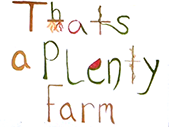The property comprises 3 acres of floodplain agricultural land, bounded by the Connecticut River on the North, traditional tractor farms on the East and West, and a dirt town road (50 feet to the Connecticut River) on the South.
The purpose of the project is to apply several different approaches to the goal of creating a sustainable, low carbon footprint, market-and-sustenance, 4-season farm that builds soil, restores habitat, and inspires healthy, local eating and environmentally-responsible living. We aim to be a positive contributor, feeding solar energy to the grid, and practicing low-environmental-impact techniques to produce safe food for a local market. One long-term goal will be to add an education component. We sell garlic for cash as seed to another organic farm, and plan to add horseradish as a market crop. We also aim to start a Winter CSA, offering greenhouse crops grown using organic techniques (spinach, kale, turnips) in unheated greenhouses. We feed 6 members of our family vegetables year-round, including herbs. Perhaps we will add chickens and/or bees. It is not allowed to construct a residence on this floodplain farm, so we reside 2 miles away via bike path.
The farm has four discrete sections:
- a “summer farm”, riverside, with 30 raised beds and one greenhouse
- an orchard/berry field. The orchard is being developed according to permaculture techniques (guilds and interplanting).
- a 2-acre “natural” section, intended as pollinator and wildlife habitat.
- a “winter farm,” adjacent to the town road, which has 2 unheated winter greenhouses. This area is planted with cover crops for compost (sunflowers, buckwheat, red clover, chamomile), and a hazelburt tree windbreak. We will install a small solar array to cover all the electrical needs of starting seeds in one of the greenhouses; the array will be grid-tied, so all surplus energy will flow to other customers. We will explore alternative energy storage techniques (suitable for floodplains, such as earthbag thermal mass walls) for the winter greenhouses.
We hand-cultivate raised beds on one-half acre of land, and also in 3 unheated greenhouses, using GROWbiointensive farming techniques. Two acres are to be kept as pollinator and wildlife habitat. There is also a riparian section/campsite, where mints, nettle, comfrey, violets, and sumac thrive. We do not use a tractor. After initial double-digging of beds to aerate the compacted soil (the land was long farmed according to conventional techniques, but has lain fallow for several years); we aim to maintain them without tilling. We plant paths with clover, and unplanted beds with cover crops, so very little soil is exposed to erosion. We do not irrigate; rather, we fill troughs from a point well, and hand water as necessary. We aim to grow our own compost and fertilizer/nutrients (60% of our crops are for this purpose), so as to minimize the need to bring resources in from other farms, and also to provide habitat for pollinators, birds, and wildlife.
Teachers and greatest influences:
John Jeavons, Ecology Action: GROWBiointensive Mini-Farming
- 60% of our crops are for compost
- hand-farming
- grow as many calories and compost as possible in the smallest possible area with the fewest resources and least amount of effort
Elliot Coleman, Four Season Farm
Toby Hemenway, Permaculture concepts (Gaia’s Garden)
Dave Jacke, Eric Toensmeier, Edible Forest Garden
One Straw Revolution (Fukuoka)
